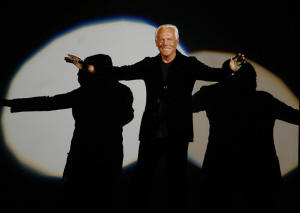Giorgio Armani, who dressed the powerful and famous from boardroom to
Hollywood, dies at 91
[September 05, 2025]
By COLLEEN BARRY and DANIELA PETROFF
MILAN (AP) — Giorgio Armani, the iconic Italian designer who turned the
concept of understated elegance into a multibillion-dollar fashion
empire, died Thursday, his fashion house confirmed. He was 91.
Armani died at home, "peacefully, surrounded by his loved ones," the
fashion house said. “Indefatigable to the end, he worked until his final
days, dedicating himself to the company, the collections and the many
ongoing and future projects."
Armani, one of the most recognizable names and faces in the global
fashion industry, missed Milan Fashion Week in June 2025 for the first
time during the previews of Spring-Summer 2026 menswear to recover from
an undisclosed condition.
He was planning a major event to celebrate 50 years of his signature
Giorgio Armani fashion house during Milan Fashion Week this month.
A public viewing will be held in the Armani Theater where he unveiled
his ready-to-wear collections on Saturday and Sunday. The funeral will
be held privately, and no details were released.
Condolences and remembrances poured in from political leaders and other
Milan fashion designers.
"The world lost a giant today. He made history and will be remembered
forever," said Donatella Versace, whose late brother Gianni Versace was
a stylistic rival of Armani in the 1990s.
Julia Roberts, who memorably wore an oversized Armani suit to the 1990
Golden Globes, posted a photo of the pair together with the text: “A
true friend. A Legend,” followed by a broken heart emoji.

Italian Premier Giorgia Meloni, who often dressed in Armani's business
attire, remembered the designer for his ”elegance, sobriety and
creativity," and said he was “a symbol of the best Italy.”
Starting with an unlined jacket, a simple pair of pants and an urban
palette, Armani put Italian ready-to-wear style on the international
fashion map in the late 1970s, creating an instantly recognizable
relaxed silhouette that has propelled the fashion house for half a
century.
From the executive office to the Hollywood screen, Armani dressed the
rich and famous in classic tailored styles, fashioned in supersoft
fabrics and muted tones. His handsome black tie outfits and glittering
evening gowns often stole the show on award season red carpets.
At the time of his death, Armani had put together an empire worth over
$10 billion, which along with clothing included accessories, home
furnishings, perfumes, cosmetics, books, flowers and even chocolates,
ranking him in the world’s top 200 billionaires, according to Forbes.
The designer also owned several bars, clubs, restaurants and his own
basketball team, Olympia Milano. Armani opened more than 20 restaurants
from Milan to Tokyo since 1998, and two hotels, one in Dubai in 2009 and
another in Milan, in 2010.
Armani himself was the foundation of his style
Armani style began with Giorgio Armani himself, from the penetrating
blue eyes framed in a permanent tan and early-age shock of silver hair,
to the trademark dark trousers and T-shirt work clothes and the
minimalist decoration of his private homes.
Armani’s fashion vision was that of easygoing elegance where attention
to detail made the difference.
“I design for real people. There is no virtue whatsoever in creating
clothes and accessories that are not practical,” he liked to say when
asked to identify his clientele.

In conversation, the designer’s disarming smile and exquisitely mild
manners belied the tough businessman underneath, who was able to turn
creative talent into a fashion empire worth over $10 billion. Never a
merger nor a sale, Re Giorgio (King George) as the Italians call him,
was always his own boss.
Born July 11, 1934, in Piacenza, a small town south of Milan, Armani
dreamed of becoming a doctor before a part-time job as a window
decorator in a Milan department store opened his eyes to the world of
fashion.
In 1975, Armani and his partner Sergio Galeotti sold their Volkswagen
for $10,000 to start up their own menswear ready-to-wear label.
Womenswear followed a year later.
The symbol of his new style was the liningless sports jacket, which was
launched in the late 1970s and became an instant success from Hollywood
to Wall Street. The designer paired the jacket with a simple T-shirt, an
item of clothing he termed “the alpha and omega of the fashion
alphabet.”
The Armani suit soon became a must in the closet of the well-heeled man.
And for women, the introduction of the pantsuit in the executive
workroom was all but revolutionary. Dubbed the “power suit” with its
shoulder-padded jacket and man-tailored trousers, it became the
trademark of the rising class of businesswomen in the 1980s.
Over the years Armani would soften the look with delicate detailing,
luxurious fabrics and brighter shades for his basic beige and gray
palette. His insistence on pants and jackets led some critics to label
his fashion “androgynous.”

[to top of second column]
|

Giorgio Armani receives his share of applause after presenting
his Emporio Fall-Winter 2007-2008 men's fashion collection, during
the Milan Men's Fashion Week, in Milan, Italy, Monday, Jan. 15,
2007. (AP Photo/Luca Bruno, File)
 Armani hits Hollywood
The 1980 film classic “American Gigolo” launched both Armani and
actor Richard Gere on their Hollywood careers. Dressed in Armani,
Gere became America’s new favorite heartthrob, and “Geeorgeeo” as
they called him, the glam set’s most popular designer.
The Hollywood connection earned him wardrobe film credits in over
200 films, and in 2003 a place on Rodeo Drive’s “Walk of Style.”
Oscar night always sparkled, with smart suiting for the men and
glittering gowns for the ladies. The 2009 best actor winner Sean
Penn picked up his statue in a black-on-black Armani outfit, while
best actress nominee Anne Hathaway walked the red carpet in a
shimmering white strapless evening gown from Armani’s latest Prive
couture collection.
Other longtime devotees included Jodie Foster, George Clooney,
Sophia Loren and Brad Pitt. David and Victoria Beckham were the
“face” of his 2009 underwear ad campaign.
So significant was the impact of Armani style, not only on how
people dressed but how they approached fashion, that in 2000 New
York’s Guggenheim museum presented a retrospective of Armani’s first
25 years in fashion.
Marking the Giorgio Armani fashion house's 40th anniversary, he
opened his own museum in Milan, called Armani Silos, located
opposite his Armani Theater. For its 50th, he launched Archivio
Armani, a digital archive last month.
“I love things that age well, things that don’t date and become
living examples of the absolute best,” Armani said of his efforts.
Armani has gone well beyond fashion
Armani, who maintained a firm grip on his empire and collections
until the end, had been reluctant to discuss succession, but had
announced a foundation as a succession tool to avoid his businesses
being split up. A rarity in the Italian fashion world, he never sold
even a part of his company to an outsider.

He also indicated the creative succession would go to longtime
collaborator Leo Dell’Orco and his niece Silvana Armani, who have
headed the menswear and womenswear collections, respectively, for
all Armani collections: Giorgio Armani, Emporio Armani and Armani
Exchange.
Today, the Armani empire has an army of more than 9,000 employees,
who consider themselves part of a family, with women comprising half
the executive suite, along with seven industrial hubs and over 600
stores worldwide, according to figures released in 2023. Along with
clothes and accessories, the company produces perfumes, cosmetics
and home furnishings, as well as selling its own candy, flowers and
even books.
His most recent purchase was of the historic La Capannina restaurant
on the Italian Riviera in Forte dei Marmi, where he used to spend
holidays with Galeotti.
In the realm of fashion hobbies, Armani owned several bars,
restaurants and clubs, as well as the basketball team. Recreation
time was spent in getaways in Broni in the countryside near Milan,
the isle of Pantelleria off Sicily and St. Tropez on the French
Riviera. Each home bore the trademark of Armani design: bare walls,
important pieces, few knickknacks.
Like many of his colleagues, Armani tried to give back some of the
fame and fortune he amassed during the heyday of the “moda Milanese”
which put Italian ready-to-wear at the center of the world’s fashion
map at the turn of the millennium. Personally involved in several
charity organizations devoted to children and a staunch supporter of
the battle against AIDS, in 2002 Armani was named a U.N. goodwill
ambassador for refugees.

Galeotti died in 1985. Armani had no children but was very close to
his niece Roberta. She abandoned a budding film career to become his
director of public relations, and often represented her uncle, who
wasn’t much of a partygoer, at social events. More recently, she has
been a key go-between with the celebrity world as head of VIP
relations.
In 2006, she orchestrated the top-billed wedding of actors Tom
Cruise and Katie Holmes in a medieval castle outside Rome, while
Uncle Giorgio designed the attire for both bride and groom.
Armani is survived by his sister Rosanna, a former fashion model,
and her son Andrea Camerana; and nieces Silvana and Roberta, the
daughters of his late brother Sergio.
____
Daniela Petroff, who covered Milan fashion for the Associated Press
for more than three decades, retired in 2017.
All contents © copyright 2025 Associated Press. All rights reserved |